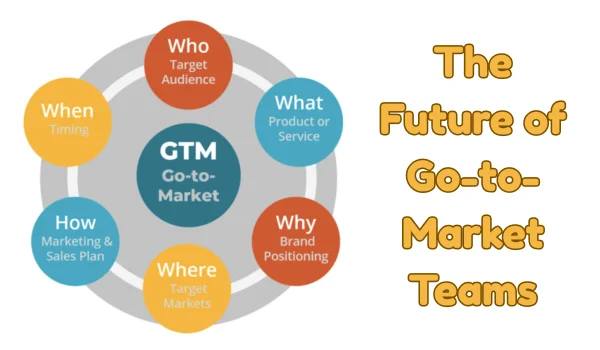The way companies go to market is undergoing a seismic shift.
In the past, sales and marketing could afford to work in parallel lanes. Marketing filled the funnel, sales closed deals, and RevOps tracked what happened in between. But in today’s hyper-digital environment, where buyers leave behind hundreds of intent signals before ever speaking to a rep, that fragmented model is no longer enough.
Modern go-to-market (GTM) success now depends on data, speed, and alignment. Winning teams aren’t just generating leads; they’re orchestrating experiences powered by unified customer intelligence and real-time insights. Artificial intelligence is accelerating this evolution, helping businesses predict buyer behavior, personalize outreach, and close gaps between departments that once spoke entirely different languages.
This convergence of AI, data, and GTM strategy is redefining what high-performing revenue teams look like. Instead of chasing prospects, they’re building predictable growth systems that sense, adapt, and act faster than the competition.
The Legacy GTM Model Is Breaking

For years, go-to-market teams operated in silos. Marketing focused on generating leads, sales on closing deals, and RevOps on reporting what went wrong when targets were missed. Each department had its own data, its own KPIs, and its own definition of success.
While this worked in a slower, less connected market, today it’s a recipe for inefficiency.
In most organizations, data fragmentation is the silent killer of performance. Marketing automation tools capture one version of a prospect’s identity, while sales CRMs hold another, often incomplete or outdated. Meanwhile, operations teams struggle to make sense of conflicting dashboards.
Even worse, the traditional GTM model relies on manual decision-making. Teams spend hours debating target segments or campaign priorities based on gut feeling rather than intelligence. This slows everything down and makes it nearly impossible to scale.
The modern buyer expects personalized, frictionless engagement, something that siloed teams simply can’t deliver. Without a shared data foundation and AI-assisted workflows, businesses end up reacting to the market instead of anticipating it. And that’s where the cracks in the legacy GTM model start to widen, setting the stage for a smarter, more integrated future.
Data as the New Fuel for GTM
In today’s B2B landscape, data is the most valuable competitive asset, but only if it’s accurate, unified, and actionable.
Every click, email open, content download, and conversation reveals a signal about a buyer’s intent. Yet for many companies, this information remains scattered across disconnected systems. Without a unified view, teams can’t see the full story of their customers or anticipate what they’ll need next.
High-performing GTM teams treat data not as a byproduct, but as the engine of growth. They consolidate insights from marketing automation, CRM, and customer success platforms using GTM software for B2B teams to build a single source of truth.. This unified data layer allows for deeper segmentation, sharper targeting, and faster decision-making, the kind that drives consistent pipeline growth.
The next evolution is AI-enhanced intelligence. Artificial intelligence can analyze vast streams of behavioral and firmographic data, uncover hidden buying patterns, and recommend optimal actions in real time. Instead of guessing which accounts are ready to buy, GTM teams can now focus where intent is highest and timing is perfect.
This shift turns data into momentum. Rather than acting on static reports, GTM teams operate like living systems, constantly learning, adapting, and improving. It’s this data-first foundation that makes AI-powered go-to-market strategies not just possible, but unstoppable.
Enter the AI-Powered GTM Team
The next generation of go-to-market teams looks very different from those of the past. Instead of siloed departments running on separate dashboards, AI-powered GTM teams operate as an integrated ecosystem where data flows freely, decisions happen faster, and growth becomes predictable.
Artificial intelligence serves as the connective tissue that unites strategy, execution, and measurement. It identifies the ideal customer profile (ICP), prioritizes accounts with the highest buying intent, and automatically recommends the best next steps for engagement. Tasks that once took days, like segmenting leads or qualifying prospects, now happen in seconds.
This automation doesn’t replace people; it amplifies human expertise. Sales teams spend more time closing deals instead of cleaning spreadsheets. Marketers fine-tune campaigns based on real-time insights instead of quarterly reports. RevOps finally gets the end-to-end visibility needed to predict revenue outcomes with confidence.
By integrating AI into every stage of the buyer journey, companies move from reactive selling to proactive orchestration, anticipating customer needs before competitors even notice them. This is where the modern GTM organization begins to outpace its peers: not by working harder, but by working smarter with intelligence as its foundation.
Where Strategy Meets Intelligence
True transformation doesn’t come from adopting more tools. It comes from connecting strategy and intelligence into one unified motion.
The most successful GTM teams are not just using AI for automation; they’re aligning it with a clear strategic vision that bridges data insights and business goals.
This convergence changes everything. Instead of starting with arbitrary campaigns, teams begin with a shared strategic framework: Who are we targeting? Why now? What signals indicate readiness to buy? AI then translates those strategic priorities into actionable workflows, automatically surfacing accounts, orchestrating outreach, and monitoring engagement across the funnel.
Culturally, this convergence also breaks long-standing barriers. Marketing no longer measures success by MQLs alone; it shares growth KPIs with sales and RevOps. Leadership gains transparency into pipeline health, while AI keeps every team aligned on the same objectives.
GTM teams that embrace this blend of intelligence and intent are the ones building organizations ready not just for today’s complexity, but for the next wave of opportunity.
Preparing for the Future GTM Organization
As AI and data-driven tools redefine the GTM landscape, the next challenge is transformation. The future-ready GTM organization is one that can adapt faster than the market changes, using intelligence not only to optimize workflows but also to reshape how teams think and collaborate.
The starting point is a unified data foundation. Every department: marketing, sales, RevOps, and customer success, must operate from the same, constantly refreshed source of truth. This ensures that every campaign, conversation, and decision reflects the most accurate understanding of the buyer.
Next, leaders must rethink KPIs and incentives. Instead of measuring siloed metrics like lead volume or close rate, teams should align around shared growth outcomes: revenue velocity, deal quality, and customer lifetime value. When data and accountability are transparent, alignment naturally follows.
Finally, building the GTM team of the future means upskilling for intelligence. Training teams to interpret AI-driven insights, ask the right questions, and adapt strategy in real time will be the new competitive edge. The companies winning in 2030 won’t just have the best tools, they’ll have the most agile, data-literate people behind them.
The future GTM organization will blend human intuition with machine precision, a partnership where creativity and computation drive growth together.
The GTM Team of 2030
The go-to-market team of the future won’t be defined by headcount or hierarchy, but by how intelligently it operates. As AI, data, and strategy converge, the most successful organizations will be those that can continuously learn from every customer signal and turn that insight into rapid, coordinated action.
By 2030, we’ll see GTM teams function less like separate departments and more like a synchronized ecosystem, marketing, sales, and RevOps moving as one, guided by real-time intelligence. AI will handle the noise, surfacing what matters most, while human teams focus on creativity, storytelling, and relationship-building.
The future GTM playbook is being written right now. Those who embrace this convergence early will lead markets, close faster, and grow smarter, not by chance, but by design.

Shashi Kant is the Founder and Editor of BusinessScroller.com, a leading platform for business insights, finance trends, and industry analysis. With a passion for journalism and expertise in business reporting, he curates well-researched content on market strategies, startups, and corporate success stories. His vision is to provide valuable information that empowers entrepreneurs and professionals. Under his leadership, BusinessScroller.com has grown into a trusted source for in-depth articles, customer care guides, and financial expertise.


